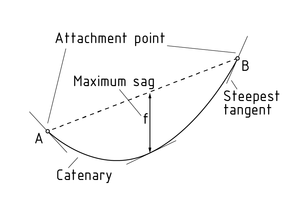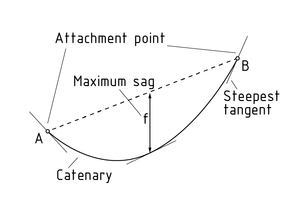
Choose one
or multiple languages
0,1,1
- German
- English
- Chinese
- Spanish
Cable

A cable or Chain is a mechanical element that is unable to absorb either compressive forces or Bending moments and is therefore described as flexible. The dead weight g of cables and chains influences the path they follow.
If a cable is suspended between two attachment points, A and B, it forms a catenary. This line represents the influence of the distributed weight load q on the cable. The maximum cable Force is at the attachment point where the cable tangent is steeper.
In the diagram, the maximum cable force is at point B. In the case of cables with attachment points at the same height, the maximum sag f is in the centre.
Key parameters for calculating the catenary are:
- the cable's length l
- the weight per length q
- the coordinates of attachment points A and B
Seil

Ein Seil oder eine Kette sind mechanische Elemente, die weder Druckkräfte noch Biegemomente aufnehmen können und daher als biegeweich bezeichnet werden. Das Eigengewicht g der Seile und Ketten beeinflusst den Seil- bzw. den Kettenverlauf.
Hängt ein Seil zwischen zwei Befestigungspunkten A und B, bildet es eine sogenannte Kettenlinie. Diese Linie repräsentiert den Einfluss der Gewichtsstreckenlast q auf das Seil. In dem Befestigungspunkt, in dem die Tangente des Seils steiler verläuft, herrscht die maximale Seilkraft.
In der Abbildung wirkt in Punkt B die größte Seilkraft. Der maximale Durchhang f befindet sich bei Seilen, deren Befestigungspunkte auf gleicher Höhe liegen, in der Mitte.
Wichtige Parameter zur Berechnung der Kettenlinie sind:
- die Länge des Seils l
- das Gewicht pro Länge q
- die Koordinaten der Befestigungspunkte A und B
索

索链是一种较为灵活的机械构件,它不能承载压力或弯矩。索链的静重g会影响其工作路径。
如果一个索被悬挂在两个连接点A和B之间,就形成了悬链线。这条线代表着分布式的重力载荷q对索的影响。索上的最大载荷位于连接点处,此处索线对应的切线斜率最大。
在图中,索上的最大载荷位于B点。如果两个连接点的高度一致,那么索最大凹陷处f位于中心位置。
计算悬链线的重要参数有:
索的长度l
单位长度的质量 q
连接点的坐标 A 和 B
在静重作用下索的凹陷
Cables

Un cable o cadena es un elemento mecánico que no puede absorber ni las fuerzas de compresión ni los momentos de flexión y, por lo tanto, se describe como flexible. El peso muerto g de cables y cadenas influye la ruta que siguen.
Si un cable está suspendido entre dos puntos de sujeción, A y B, forma una catenaria. Esta línea representa la influencia de la carga distribuida q en el cable. La fuerza máxima de cable está en el punto de sujeción donde la tangente del cable es más pronunciada.
En el diagrama, la fuerza máxima del cable se encuentra en el punto B. En el caso del cable con puntos de sujeción a la misma altura, el hundimiento máximo f está en el centro.
Los parámetros clave para calcular la catenaria son:
La longitud del cable l
El peso por longitud q
Las coordenadas de los puntos de sujeción A y B
Hundimiento del cable por su peso muerto
